University Management Report: Decision Making Analysis
VerifiedAdded on 2022/10/01
|7
|2069
|67
Report
AI Summary
This report critically analyzes managerial decision-making processes, focusing on the concepts of overconfidence, bounded awareness, and fairness and equity in light of Herbert A. Simon's theory of bounded rationality. It explores how overconfidence can lead to inaccurate decisions, bounded awareness can limit the consideration of all relevant factors, and the pursuit of fairness and equity may sometimes conflict with rational decision-making. The report provides examples to illustrate each concept, discussing the potential benefits and drawbacks within an organizational context. It emphasizes the importance of considering all variables and environmental constraints to arrive at effective decisions, and suggests strategies such as training and awareness exercises to improve decision-making processes.
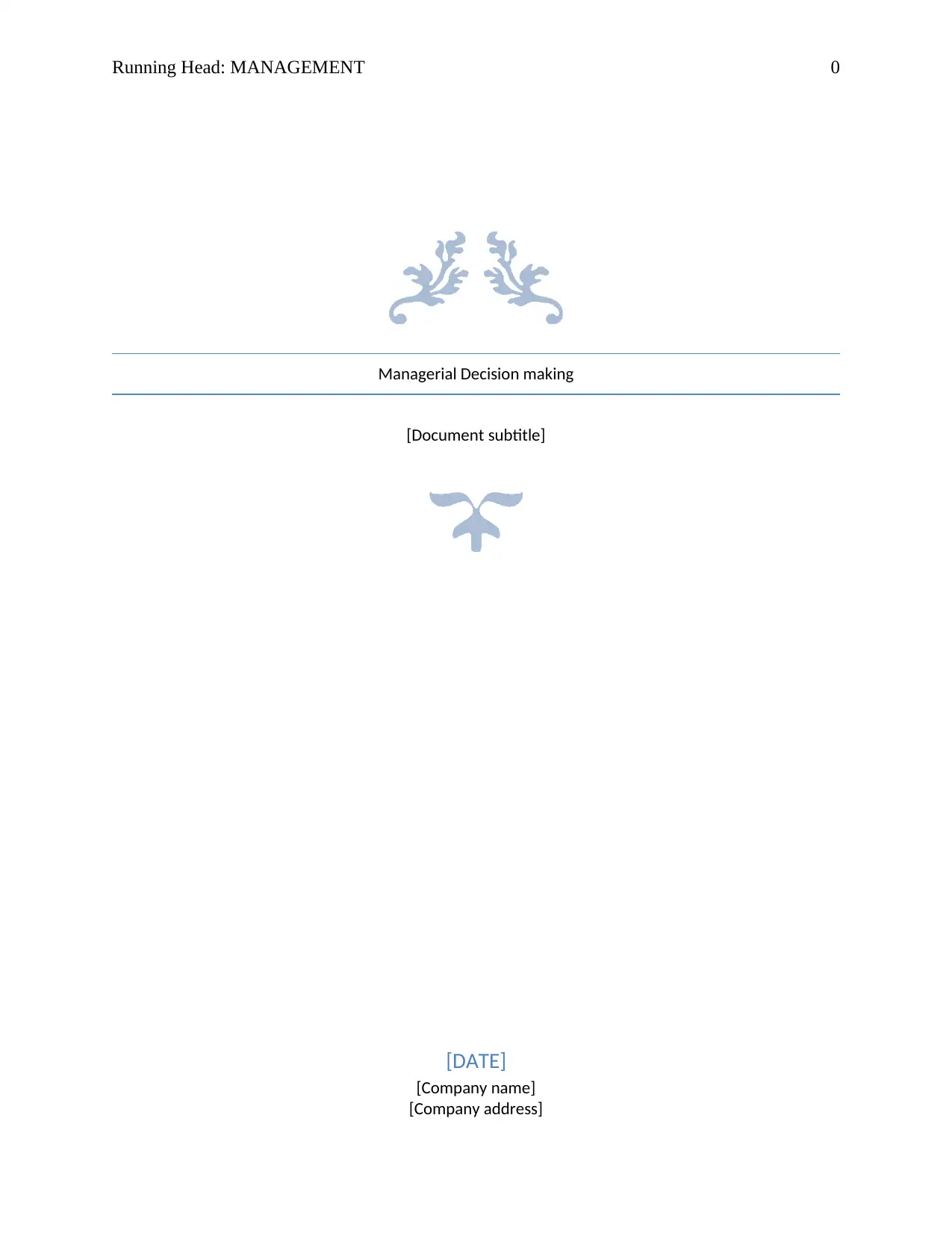
Running Head: MANAGEMENT 0
Managerial Decision making
[Document subtitle]
[DATE]
[Company name]
[Company address]
Managerial Decision making
[Document subtitle]
[DATE]
[Company name]
[Company address]
Paraphrase This Document
Need a fresh take? Get an instant paraphrase of this document with our AI Paraphraser
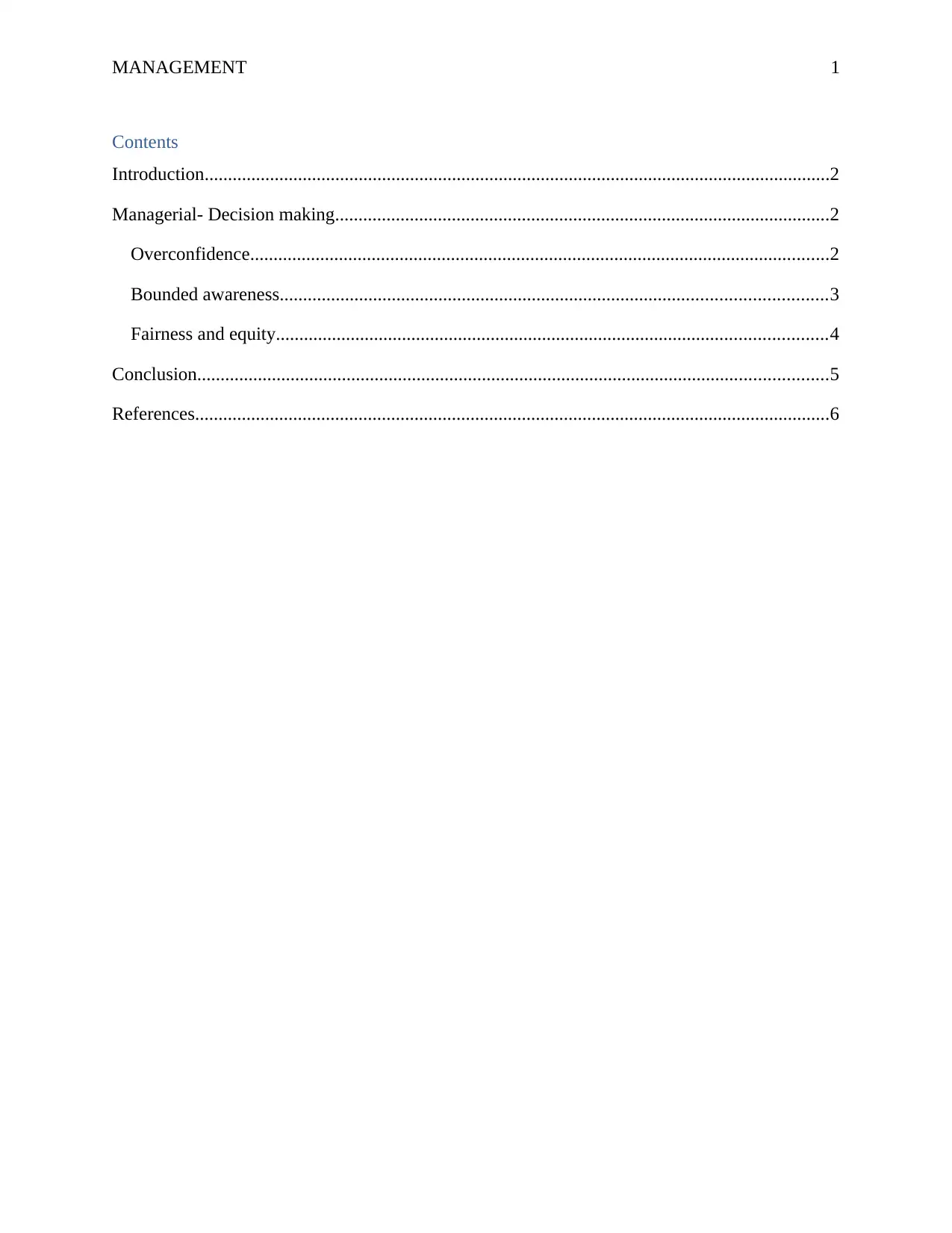
MANAGEMENT 1
Contents
Introduction......................................................................................................................................2
Managerial- Decision making..........................................................................................................2
Overconfidence............................................................................................................................2
Bounded awareness.....................................................................................................................3
Fairness and equity......................................................................................................................4
Conclusion.......................................................................................................................................5
References........................................................................................................................................6
Contents
Introduction......................................................................................................................................2
Managerial- Decision making..........................................................................................................2
Overconfidence............................................................................................................................2
Bounded awareness.....................................................................................................................3
Fairness and equity......................................................................................................................4
Conclusion.......................................................................................................................................5
References........................................................................................................................................6
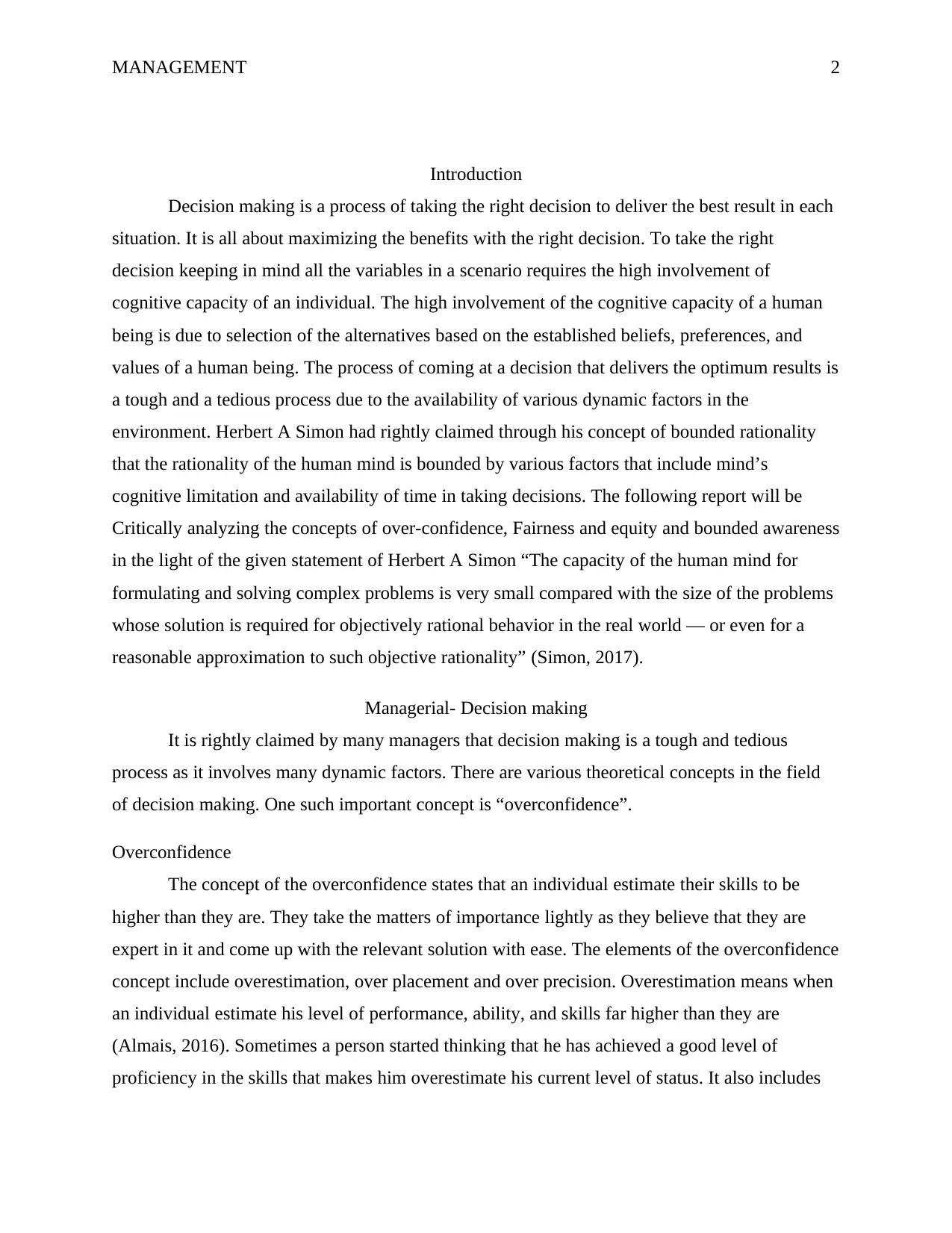
MANAGEMENT 2
Introduction
Decision making is a process of taking the right decision to deliver the best result in each
situation. It is all about maximizing the benefits with the right decision. To take the right
decision keeping in mind all the variables in a scenario requires the high involvement of
cognitive capacity of an individual. The high involvement of the cognitive capacity of a human
being is due to selection of the alternatives based on the established beliefs, preferences, and
values of a human being. The process of coming at a decision that delivers the optimum results is
a tough and a tedious process due to the availability of various dynamic factors in the
environment. Herbert A Simon had rightly claimed through his concept of bounded rationality
that the rationality of the human mind is bounded by various factors that include mind’s
cognitive limitation and availability of time in taking decisions. The following report will be
Critically analyzing the concepts of over-confidence, Fairness and equity and bounded awareness
in the light of the given statement of Herbert A Simon “The capacity of the human mind for
formulating and solving complex problems is very small compared with the size of the problems
whose solution is required for objectively rational behavior in the real world — or even for a
reasonable approximation to such objective rationality” (Simon, 2017).
Managerial- Decision making
It is rightly claimed by many managers that decision making is a tough and tedious
process as it involves many dynamic factors. There are various theoretical concepts in the field
of decision making. One such important concept is “overconfidence”.
Overconfidence
The concept of the overconfidence states that an individual estimate their skills to be
higher than they are. They take the matters of importance lightly as they believe that they are
expert in it and come up with the relevant solution with ease. The elements of the overconfidence
concept include overestimation, over placement and over precision. Overestimation means when
an individual estimate his level of performance, ability, and skills far higher than they are
(Almais, 2016). Sometimes a person started thinking that he has achieved a good level of
proficiency in the skills that makes him overestimate his current level of status. It also includes
Introduction
Decision making is a process of taking the right decision to deliver the best result in each
situation. It is all about maximizing the benefits with the right decision. To take the right
decision keeping in mind all the variables in a scenario requires the high involvement of
cognitive capacity of an individual. The high involvement of the cognitive capacity of a human
being is due to selection of the alternatives based on the established beliefs, preferences, and
values of a human being. The process of coming at a decision that delivers the optimum results is
a tough and a tedious process due to the availability of various dynamic factors in the
environment. Herbert A Simon had rightly claimed through his concept of bounded rationality
that the rationality of the human mind is bounded by various factors that include mind’s
cognitive limitation and availability of time in taking decisions. The following report will be
Critically analyzing the concepts of over-confidence, Fairness and equity and bounded awareness
in the light of the given statement of Herbert A Simon “The capacity of the human mind for
formulating and solving complex problems is very small compared with the size of the problems
whose solution is required for objectively rational behavior in the real world — or even for a
reasonable approximation to such objective rationality” (Simon, 2017).
Managerial- Decision making
It is rightly claimed by many managers that decision making is a tough and tedious
process as it involves many dynamic factors. There are various theoretical concepts in the field
of decision making. One such important concept is “overconfidence”.
Overconfidence
The concept of the overconfidence states that an individual estimate their skills to be
higher than they are. They take the matters of importance lightly as they believe that they are
expert in it and come up with the relevant solution with ease. The elements of the overconfidence
concept include overestimation, over placement and over precision. Overestimation means when
an individual estimate his level of performance, ability, and skills far higher than they are
(Almais, 2016). Sometimes a person started thinking that he has achieved a good level of
proficiency in the skills that makes him overestimate his current level of status. It also includes
⊘ This is a preview!⊘
Do you want full access?
Subscribe today to unlock all pages.

Trusted by 1+ million students worldwide
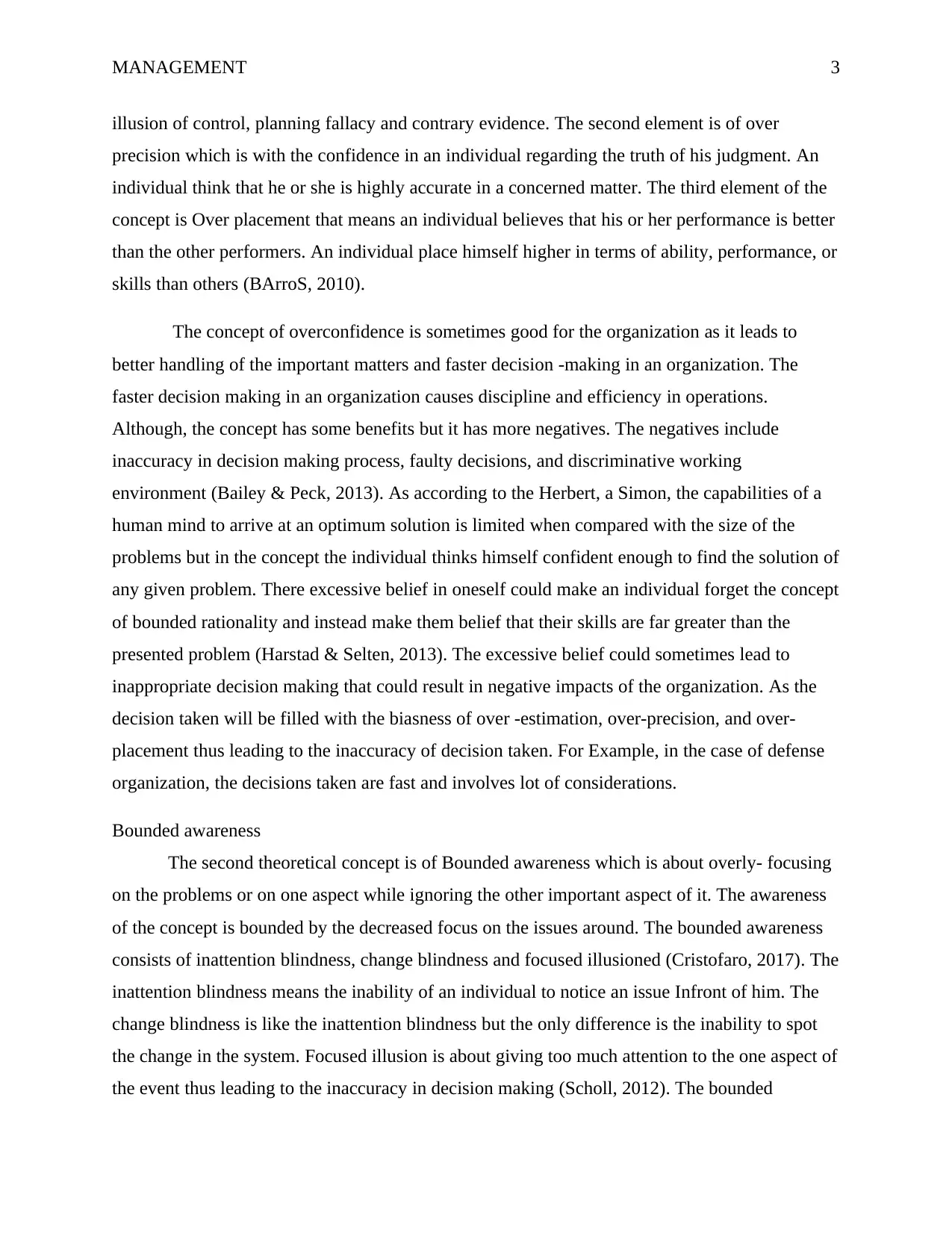
MANAGEMENT 3
illusion of control, planning fallacy and contrary evidence. The second element is of over
precision which is with the confidence in an individual regarding the truth of his judgment. An
individual think that he or she is highly accurate in a concerned matter. The third element of the
concept is Over placement that means an individual believes that his or her performance is better
than the other performers. An individual place himself higher in terms of ability, performance, or
skills than others (BArroS, 2010).
The concept of overconfidence is sometimes good for the organization as it leads to
better handling of the important matters and faster decision -making in an organization. The
faster decision making in an organization causes discipline and efficiency in operations.
Although, the concept has some benefits but it has more negatives. The negatives include
inaccuracy in decision making process, faulty decisions, and discriminative working
environment (Bailey & Peck, 2013). As according to the Herbert, a Simon, the capabilities of a
human mind to arrive at an optimum solution is limited when compared with the size of the
problems but in the concept the individual thinks himself confident enough to find the solution of
any given problem. There excessive belief in oneself could make an individual forget the concept
of bounded rationality and instead make them belief that their skills are far greater than the
presented problem (Harstad & Selten, 2013). The excessive belief could sometimes lead to
inappropriate decision making that could result in negative impacts of the organization. As the
decision taken will be filled with the biasness of over -estimation, over-precision, and over-
placement thus leading to the inaccuracy of decision taken. For Example, in the case of defense
organization, the decisions taken are fast and involves lot of considerations.
Bounded awareness
The second theoretical concept is of Bounded awareness which is about overly- focusing
on the problems or on one aspect while ignoring the other important aspect of it. The awareness
of the concept is bounded by the decreased focus on the issues around. The bounded awareness
consists of inattention blindness, change blindness and focused illusioned (Cristofaro, 2017). The
inattention blindness means the inability of an individual to notice an issue Infront of him. The
change blindness is like the inattention blindness but the only difference is the inability to spot
the change in the system. Focused illusion is about giving too much attention to the one aspect of
the event thus leading to the inaccuracy in decision making (Scholl, 2012). The bounded
illusion of control, planning fallacy and contrary evidence. The second element is of over
precision which is with the confidence in an individual regarding the truth of his judgment. An
individual think that he or she is highly accurate in a concerned matter. The third element of the
concept is Over placement that means an individual believes that his or her performance is better
than the other performers. An individual place himself higher in terms of ability, performance, or
skills than others (BArroS, 2010).
The concept of overconfidence is sometimes good for the organization as it leads to
better handling of the important matters and faster decision -making in an organization. The
faster decision making in an organization causes discipline and efficiency in operations.
Although, the concept has some benefits but it has more negatives. The negatives include
inaccuracy in decision making process, faulty decisions, and discriminative working
environment (Bailey & Peck, 2013). As according to the Herbert, a Simon, the capabilities of a
human mind to arrive at an optimum solution is limited when compared with the size of the
problems but in the concept the individual thinks himself confident enough to find the solution of
any given problem. There excessive belief in oneself could make an individual forget the concept
of bounded rationality and instead make them belief that their skills are far greater than the
presented problem (Harstad & Selten, 2013). The excessive belief could sometimes lead to
inappropriate decision making that could result in negative impacts of the organization. As the
decision taken will be filled with the biasness of over -estimation, over-precision, and over-
placement thus leading to the inaccuracy of decision taken. For Example, in the case of defense
organization, the decisions taken are fast and involves lot of considerations.
Bounded awareness
The second theoretical concept is of Bounded awareness which is about overly- focusing
on the problems or on one aspect while ignoring the other important aspect of it. The awareness
of the concept is bounded by the decreased focus on the issues around. The bounded awareness
consists of inattention blindness, change blindness and focused illusioned (Cristofaro, 2017). The
inattention blindness means the inability of an individual to notice an issue Infront of him. The
change blindness is like the inattention blindness but the only difference is the inability to spot
the change in the system. Focused illusion is about giving too much attention to the one aspect of
the event thus leading to the inaccuracy in decision making (Scholl, 2012). The bounded
Paraphrase This Document
Need a fresh take? Get an instant paraphrase of this document with our AI Paraphraser
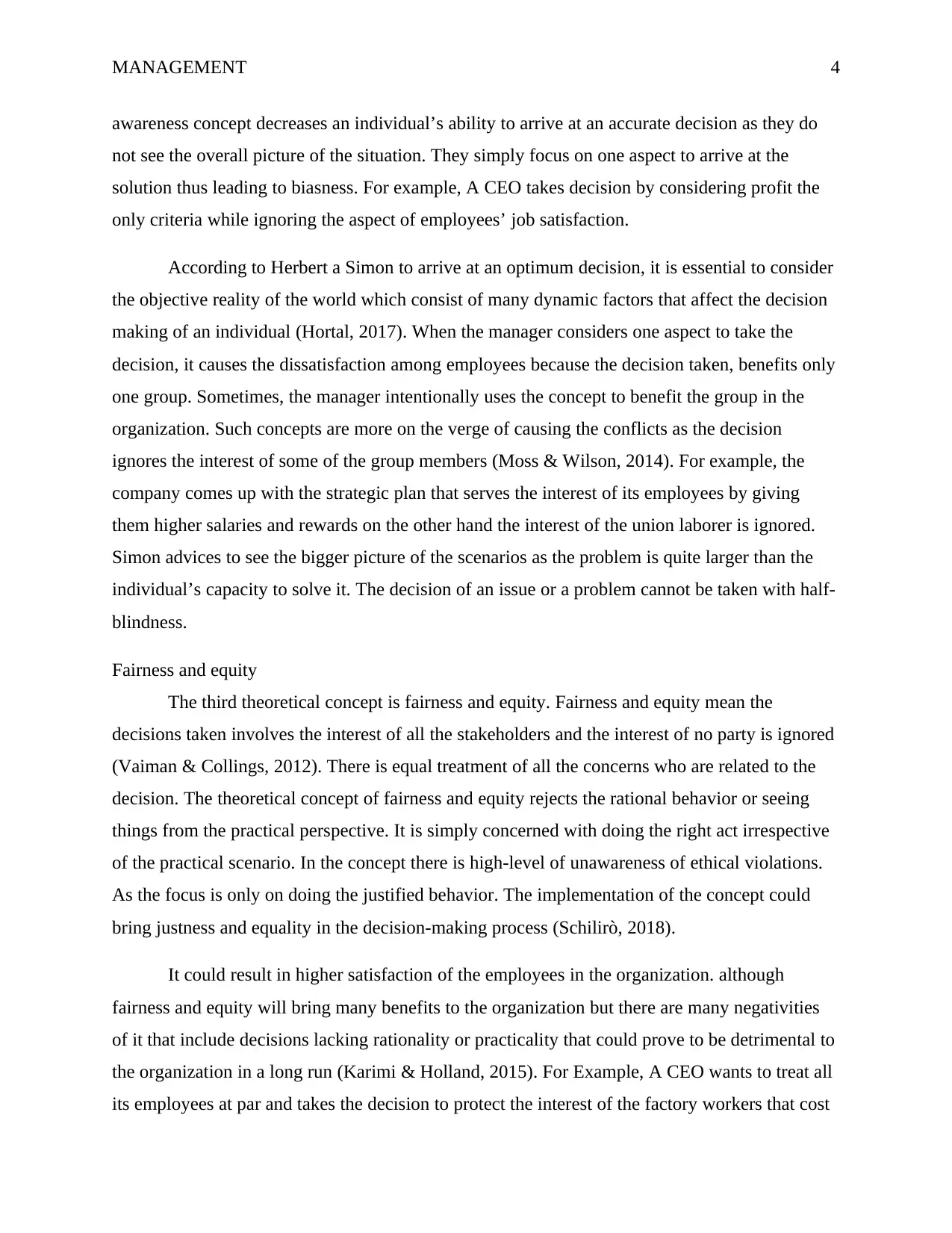
MANAGEMENT 4
awareness concept decreases an individual’s ability to arrive at an accurate decision as they do
not see the overall picture of the situation. They simply focus on one aspect to arrive at the
solution thus leading to biasness. For example, A CEO takes decision by considering profit the
only criteria while ignoring the aspect of employees’ job satisfaction.
According to Herbert a Simon to arrive at an optimum decision, it is essential to consider
the objective reality of the world which consist of many dynamic factors that affect the decision
making of an individual (Hortal, 2017). When the manager considers one aspect to take the
decision, it causes the dissatisfaction among employees because the decision taken, benefits only
one group. Sometimes, the manager intentionally uses the concept to benefit the group in the
organization. Such concepts are more on the verge of causing the conflicts as the decision
ignores the interest of some of the group members (Moss & Wilson, 2014). For example, the
company comes up with the strategic plan that serves the interest of its employees by giving
them higher salaries and rewards on the other hand the interest of the union laborer is ignored.
Simon advices to see the bigger picture of the scenarios as the problem is quite larger than the
individual’s capacity to solve it. The decision of an issue or a problem cannot be taken with half-
blindness.
Fairness and equity
The third theoretical concept is fairness and equity. Fairness and equity mean the
decisions taken involves the interest of all the stakeholders and the interest of no party is ignored
(Vaiman & Collings, 2012). There is equal treatment of all the concerns who are related to the
decision. The theoretical concept of fairness and equity rejects the rational behavior or seeing
things from the practical perspective. It is simply concerned with doing the right act irrespective
of the practical scenario. In the concept there is high-level of unawareness of ethical violations.
As the focus is only on doing the justified behavior. The implementation of the concept could
bring justness and equality in the decision-making process (Schilirò, 2018).
It could result in higher satisfaction of the employees in the organization. although
fairness and equity will bring many benefits to the organization but there are many negativities
of it that include decisions lacking rationality or practicality that could prove to be detrimental to
the organization in a long run (Karimi & Holland, 2015). For Example, A CEO wants to treat all
its employees at par and takes the decision to protect the interest of the factory workers that cost
awareness concept decreases an individual’s ability to arrive at an accurate decision as they do
not see the overall picture of the situation. They simply focus on one aspect to arrive at the
solution thus leading to biasness. For example, A CEO takes decision by considering profit the
only criteria while ignoring the aspect of employees’ job satisfaction.
According to Herbert a Simon to arrive at an optimum decision, it is essential to consider
the objective reality of the world which consist of many dynamic factors that affect the decision
making of an individual (Hortal, 2017). When the manager considers one aspect to take the
decision, it causes the dissatisfaction among employees because the decision taken, benefits only
one group. Sometimes, the manager intentionally uses the concept to benefit the group in the
organization. Such concepts are more on the verge of causing the conflicts as the decision
ignores the interest of some of the group members (Moss & Wilson, 2014). For example, the
company comes up with the strategic plan that serves the interest of its employees by giving
them higher salaries and rewards on the other hand the interest of the union laborer is ignored.
Simon advices to see the bigger picture of the scenarios as the problem is quite larger than the
individual’s capacity to solve it. The decision of an issue or a problem cannot be taken with half-
blindness.
Fairness and equity
The third theoretical concept is fairness and equity. Fairness and equity mean the
decisions taken involves the interest of all the stakeholders and the interest of no party is ignored
(Vaiman & Collings, 2012). There is equal treatment of all the concerns who are related to the
decision. The theoretical concept of fairness and equity rejects the rational behavior or seeing
things from the practical perspective. It is simply concerned with doing the right act irrespective
of the practical scenario. In the concept there is high-level of unawareness of ethical violations.
As the focus is only on doing the justified behavior. The implementation of the concept could
bring justness and equality in the decision-making process (Schilirò, 2018).
It could result in higher satisfaction of the employees in the organization. although
fairness and equity will bring many benefits to the organization but there are many negativities
of it that include decisions lacking rationality or practicality that could prove to be detrimental to
the organization in a long run (Karimi & Holland, 2015). For Example, A CEO wants to treat all
its employees at par and takes the decision to protect the interest of the factory workers that cost
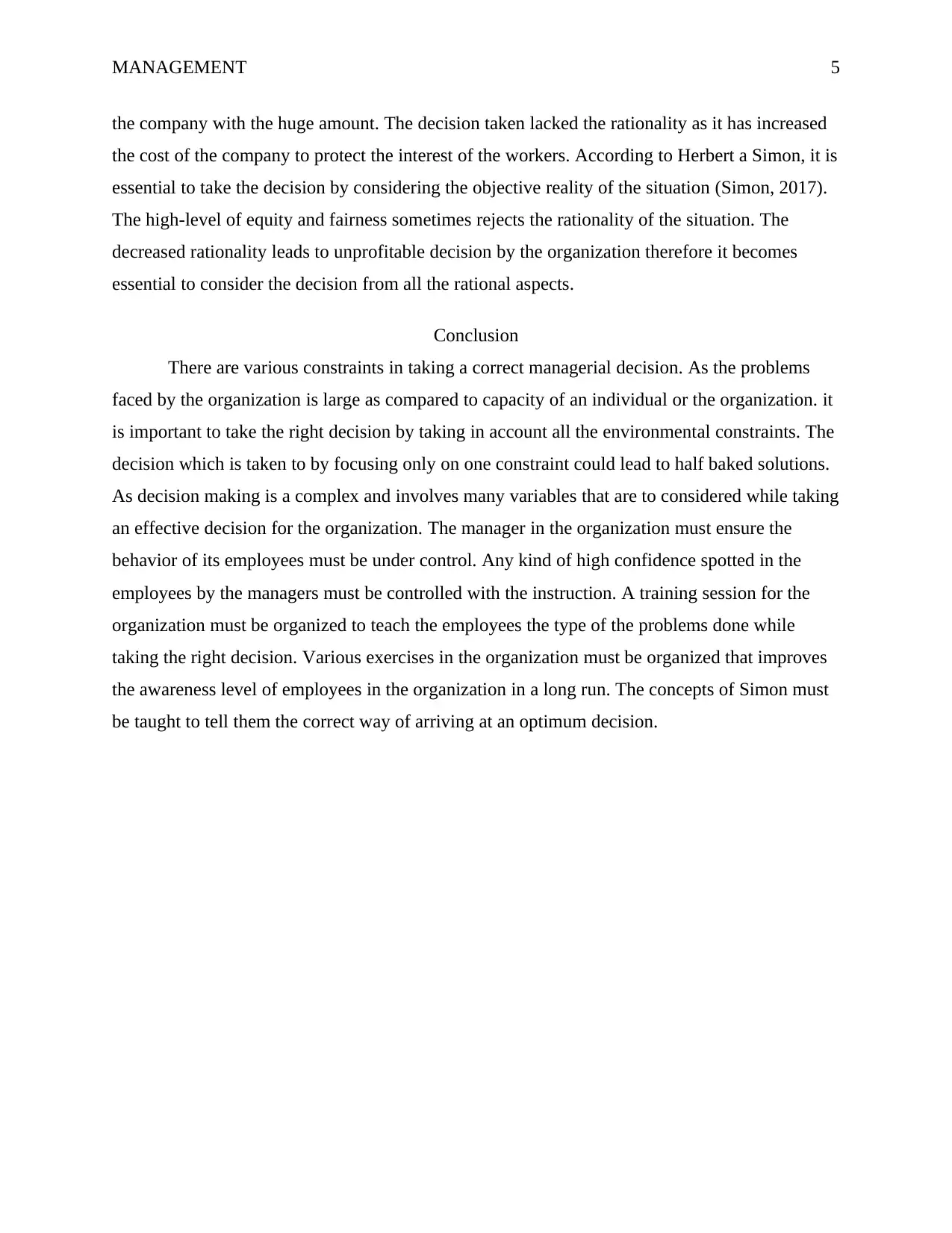
MANAGEMENT 5
the company with the huge amount. The decision taken lacked the rationality as it has increased
the cost of the company to protect the interest of the workers. According to Herbert a Simon, it is
essential to take the decision by considering the objective reality of the situation (Simon, 2017).
The high-level of equity and fairness sometimes rejects the rationality of the situation. The
decreased rationality leads to unprofitable decision by the organization therefore it becomes
essential to consider the decision from all the rational aspects.
Conclusion
There are various constraints in taking a correct managerial decision. As the problems
faced by the organization is large as compared to capacity of an individual or the organization. it
is important to take the right decision by taking in account all the environmental constraints. The
decision which is taken to by focusing only on one constraint could lead to half baked solutions.
As decision making is a complex and involves many variables that are to considered while taking
an effective decision for the organization. The manager in the organization must ensure the
behavior of its employees must be under control. Any kind of high confidence spotted in the
employees by the managers must be controlled with the instruction. A training session for the
organization must be organized to teach the employees the type of the problems done while
taking the right decision. Various exercises in the organization must be organized that improves
the awareness level of employees in the organization in a long run. The concepts of Simon must
be taught to tell them the correct way of arriving at an optimum decision.
the company with the huge amount. The decision taken lacked the rationality as it has increased
the cost of the company to protect the interest of the workers. According to Herbert a Simon, it is
essential to take the decision by considering the objective reality of the situation (Simon, 2017).
The high-level of equity and fairness sometimes rejects the rationality of the situation. The
decreased rationality leads to unprofitable decision by the organization therefore it becomes
essential to consider the decision from all the rational aspects.
Conclusion
There are various constraints in taking a correct managerial decision. As the problems
faced by the organization is large as compared to capacity of an individual or the organization. it
is important to take the right decision by taking in account all the environmental constraints. The
decision which is taken to by focusing only on one constraint could lead to half baked solutions.
As decision making is a complex and involves many variables that are to considered while taking
an effective decision for the organization. The manager in the organization must ensure the
behavior of its employees must be under control. Any kind of high confidence spotted in the
employees by the managers must be controlled with the instruction. A training session for the
organization must be organized to teach the employees the type of the problems done while
taking the right decision. Various exercises in the organization must be organized that improves
the awareness level of employees in the organization in a long run. The concepts of Simon must
be taught to tell them the correct way of arriving at an optimum decision.
⊘ This is a preview!⊘
Do you want full access?
Subscribe today to unlock all pages.

Trusted by 1+ million students worldwide
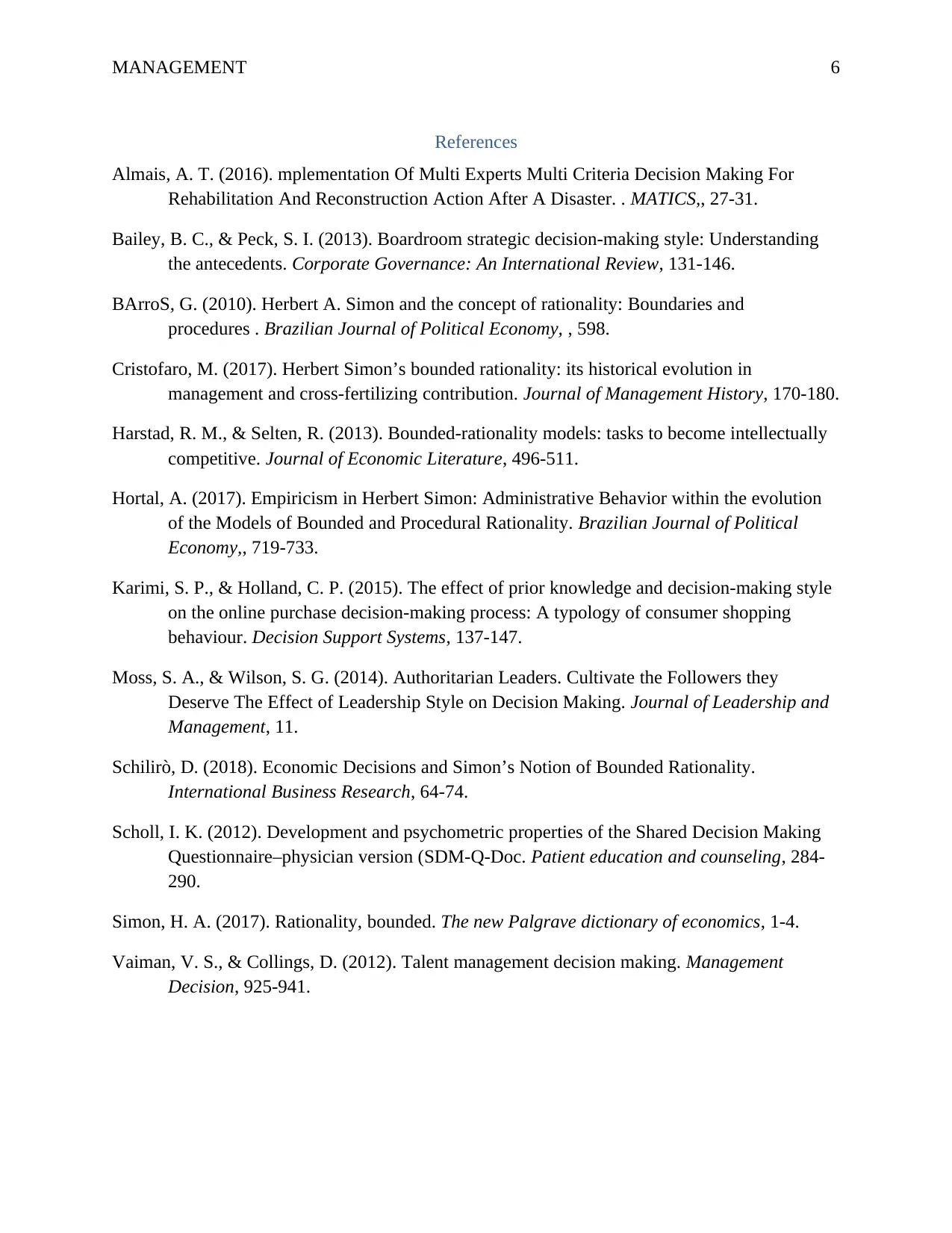
MANAGEMENT 6
References
Almais, A. T. (2016). mplementation Of Multi Experts Multi Criteria Decision Making For
Rehabilitation And Reconstruction Action After A Disaster. . MATICS,, 27-31.
Bailey, B. C., & Peck, S. I. (2013). Boardroom strategic decision‐making style: Understanding
the antecedents. Corporate Governance: An International Review, 131-146.
BArroS, G. (2010). Herbert A. Simon and the concept of rationality: Boundaries and
procedures . Brazilian Journal of Political Economy, , 598.
Cristofaro, M. (2017). Herbert Simon’s bounded rationality: its historical evolution in
management and cross-fertilizing contribution. Journal of Management History, 170-180.
Harstad, R. M., & Selten, R. (2013). Bounded-rationality models: tasks to become intellectually
competitive. Journal of Economic Literature, 496-511.
Hortal, A. (2017). Empiricism in Herbert Simon: Administrative Behavior within the evolution
of the Models of Bounded and Procedural Rationality. Brazilian Journal of Political
Economy,, 719-733.
Karimi, S. P., & Holland, C. P. (2015). The effect of prior knowledge and decision-making style
on the online purchase decision-making process: A typology of consumer shopping
behaviour. Decision Support Systems, 137-147.
Moss, S. A., & Wilson, S. G. (2014). Authoritarian Leaders. Cultivate the Followers they
Deserve The Effect of Leadership Style on Decision Making. Journal of Leadership and
Management, 11.
Schilirò, D. (2018). Economic Decisions and Simon’s Notion of Bounded Rationality.
International Business Research, 64-74.
Scholl, I. K. (2012). Development and psychometric properties of the Shared Decision Making
Questionnaire–physician version (SDM-Q-Doc. Patient education and counseling, 284-
290.
Simon, H. A. (2017). Rationality, bounded. The new Palgrave dictionary of economics, 1-4.
Vaiman, V. S., & Collings, D. (2012). Talent management decision making. Management
Decision, 925-941.
References
Almais, A. T. (2016). mplementation Of Multi Experts Multi Criteria Decision Making For
Rehabilitation And Reconstruction Action After A Disaster. . MATICS,, 27-31.
Bailey, B. C., & Peck, S. I. (2013). Boardroom strategic decision‐making style: Understanding
the antecedents. Corporate Governance: An International Review, 131-146.
BArroS, G. (2010). Herbert A. Simon and the concept of rationality: Boundaries and
procedures . Brazilian Journal of Political Economy, , 598.
Cristofaro, M. (2017). Herbert Simon’s bounded rationality: its historical evolution in
management and cross-fertilizing contribution. Journal of Management History, 170-180.
Harstad, R. M., & Selten, R. (2013). Bounded-rationality models: tasks to become intellectually
competitive. Journal of Economic Literature, 496-511.
Hortal, A. (2017). Empiricism in Herbert Simon: Administrative Behavior within the evolution
of the Models of Bounded and Procedural Rationality. Brazilian Journal of Political
Economy,, 719-733.
Karimi, S. P., & Holland, C. P. (2015). The effect of prior knowledge and decision-making style
on the online purchase decision-making process: A typology of consumer shopping
behaviour. Decision Support Systems, 137-147.
Moss, S. A., & Wilson, S. G. (2014). Authoritarian Leaders. Cultivate the Followers they
Deserve The Effect of Leadership Style on Decision Making. Journal of Leadership and
Management, 11.
Schilirò, D. (2018). Economic Decisions and Simon’s Notion of Bounded Rationality.
International Business Research, 64-74.
Scholl, I. K. (2012). Development and psychometric properties of the Shared Decision Making
Questionnaire–physician version (SDM-Q-Doc. Patient education and counseling, 284-
290.
Simon, H. A. (2017). Rationality, bounded. The new Palgrave dictionary of economics, 1-4.
Vaiman, V. S., & Collings, D. (2012). Talent management decision making. Management
Decision, 925-941.
1 out of 7
Related Documents
Your All-in-One AI-Powered Toolkit for Academic Success.
+13062052269
info@desklib.com
Available 24*7 on WhatsApp / Email
![[object Object]](/_next/static/media/star-bottom.7253800d.svg)
Unlock your academic potential
Copyright © 2020–2025 A2Z Services. All Rights Reserved. Developed and managed by ZUCOL.





